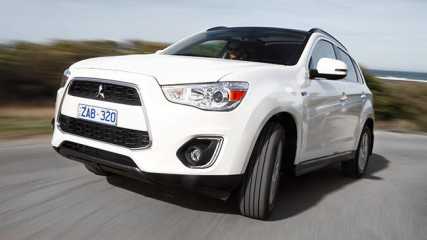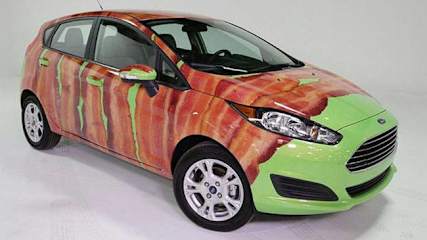Lamborghini Aventador 2013 Review
By Neil Dowling · 04 Sep 2013
The noise hurts. The exhaust note pounds the eardrums and the shockwaves turn my chest into a kettle drum in the hands of some musically-challenged maniac.All I have to do to make that noise -- that vibrating air -- disappear is to turn the console switch from "sport" to "strada" (street). That changes the engine settings, diverting the exhaust gases away from the optional performance-tuned extractors.But I can't. It's addictive not just to me but to the occupants of the cars alongside me at the traffic lights, to the cyclist I just passed a kilometre or two back down the road and to the now slightly-shaken shoppers wandering the narrow city streets. At least I presume they are equally in awe of the music as they are of the sharp-edged, hexagonal-trimmed wedge that is Lamborghini's Aventador Roadster.It is a car that shocks the senses with more than just its sound, with its razor-edged lines that defy the organic lines of contemporary transport and in its disproportionate dimensions that exaggerate its 2.3m width against a tiny 1.1m height.PRICEAnd if all that doesn't get you in, then the entry-level price of $795,000 - incidentally including about $300,000 of government taxes (so who says wealth is obscene) - is a reality check and the $929,000 on-road cost of the test car is just an impossible Monopoly number.Few cars - at least those capable of being licenced in Australia - will make your driveway look as good as this. Remarkably, it will make the driver look fantastic as well and do wonders for the person in the passenger seat.If you're introverted, drive a Pulsar. If you're here to be noticed, it's a Lamborghini and certainly one like the Aventador Roadster - there is also the Gallardo Convertible - that without its roof will make you a sunburnt star.If you've got it, flaunt it! Ferruccio Lamborghini (1916-1993), who started the company, reputedly said once about the high price of his cars: "The engine costs $150,000 - the rest you get for free."DESIGNThe hexagons that make up a large part of the Roadster's shell design - and incidentally are absent in the Aventador coupe - are a tip of the hat by Lamborghini to the element of carbon. Carbon fibre, you see, forms the bulk of the car's bodywork. The rest is jagged euphoria.The test car gets 20-inch front and 21-inch rear wheels (a $10,350 option) and glass-panelled engine cover ($14,985), a carbon-fibre fillet in the centre of the engine's vee ($4995), and metallic paint ($4875). Signs of parent company Audi are visible in some switchgear - not a bad thing, really.TECHNOLOGYToo much for this space but the engine can cut off six cylinders when coasting and the Aventador has stop-start with a capacitor - same as Mazda6! The AWD system sends power out of the front of the engine, into the gearbox between the seats, then uses one prop shaft to the rear wheels (alongside the right of the engine) and sends the other forward through a Haldex diff to the front wheels. The complexity ranks alongside Nissan GT-R's power transfer.SAFETYIt doesn’t have an Australian crash rating. If you've got $929,000 then buy one of these and give it to ANCAP and they'll crash it for you. Let me know how it fares.DRIVINGSomeone once described the acceleration of this as horizontal bungee jumping. I can't argue. Nothing comes closer to the slingshot immediacy of the Aventador with a claimed 2.9 second blink from rest to 100km/h.The first lesson is: Be very prepared when you play with the accelerator pedal. From start there's a click of the right-side paddle shifter into first gear, then a squeeze on the accelerator pedal. Then more of a squeeze and so on until I believe that the gear hasn't engaged. It has, it's just a few more hundred revs around the dominating, multi-coloured single tachometer dial before the electronic clutch bites.Then 515kW lurches forward. Leave it in "strada" mode for general street use and the exhaust note is tame and the automatic mode of the robotised seven-speed manual is almost domesticated - certainly a far cry from the early "e-gear" box in the first Gallardo that was like trying to appease a grumpy Collingwood supporter after a lost game.Depending on accelerator pressure, the box will either hold the gears back and fling them upward around 3000rpm, or roll up the cogs quickly. The steering is firm, almost heavy, and while visibility to the front is clear, the rear view is little more than a letterbox slit and to the sides - well, forget it.The car isn't hard to drive. It's the fear of failure that grips me. I drive haunted by thoughts of one tiny corner miscalculation resulting in doom in a financial vacuum yet, at the same time, the sheer exhilaration of pedalling a remarkably simple, shatteringly quick piece of hand built Italiana.Change the console-mount button the "sport" and that exhaust note erupts. There is an urgency that doesn't mix well with the lazy mid-week traffic on the coastal route. The "corsa" button keeps the exhaust bark and wail the same but turns off the electronic nanny - a move made by the brave or foolish. It also firms the steering and the gearchanges alter from abrupt to violent.Traffic lights disappear and the road sweeps and flows and traffic reduces, so the car can be moved with less restriction. Here, on the open bitumen, is where the Aventador starts to shine. Sure, it is upset by uneven bitumen that makes the suspension jiggle and the chassis jump and coachwork exhibit the occasional small squeak.But its hunger is insatiable. It eats the road and the faster - academically to speeds even intolerable in northern Italy - it goes, the more it hugs the bitumen and becomes locomotive solid. Roof up, the car is taut and quiet from wind - not road or engine noise, however - but with the two targa-type panels removed and the bevel-edge window glass down, it twirls the wind through the carpet and the leather and my remaining hair.These two targa panels, made of a composite so they're remarkably light at 6kg each, are suitably numbered so amateurs like myself can find how they slot into position beneath the shovel-shaped bonnet. Be warned: Once in place, there is no room for luggage. None. The seats - optional here in a Roadster-exclusive Elegante pack ($4440) with Lamborghini branding (add $2070) - look tiny but are supportive while being easy to access.The scissor doors are made of carbon fibre and perfectly balanced so they open and close as a two-finger exercise, far removed from the heavy hand needed for the Murcielago.VERDICTThe best Lamborghini to date.Lamborghini Aventador RoadsterPrice: from $795,000 ($929,000 on-road as tested)Warranty: 3 years/unlimited km, 3yr roadside assistCapped servicing: NoService interval: 12mths/12,000kmResale: 54%Safety: 8 airbags, ABS, ESC, EBD, TCCrash rating: Not testedEngine: 6.5-litre, V12 petrol; 515kW/690NmTransmission: 7-spd automated manual; AWDThirst: 17.2L/100km; 98RON; 398g/km CO2Dimensions: 4.8m (L), 2.0m (W), 1.1m (H)Weight: 1690kgSpare: None










-wide.jpg)


